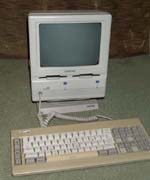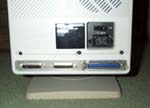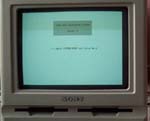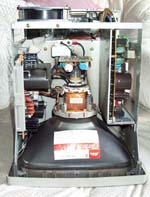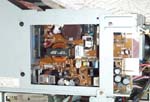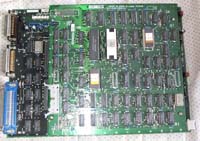I bought this Sony because it looked like a compact Mac and I wanted to know what another manufacturer associated with quality, user friendly products would cook up from similar ingredients. The Sony Series 35 Model 10 uses the now familiar 9" CRT and two 3.5" floppy drives but the mouse is noticeable by its absence.
It may be unfair to describe this computer as a Mac copy; Sony had already produced word processors that used the 3.5" drive and there aren't many ways to package the screen and drives in an original way. However the form factor is so much like the compact Mac that comparison is impossible to avoid.
The most visible differences are the tilt stand, the absence of a carrying handle and the presence of two disk drives. The stand is not robust enough to survive the mishandling that many compact Macs received.
Like an early Mac, the keyboard connects to the front of the system unit via an RJ10 connector. There is a screen brightness control on the side of the case.
The rear of the case features, from left to right, an external disk drive port, a serial port and a parallel port.
The rear plate reads:
Model OA-S2420 (OA stands for Office Automation)
Serial number 33201
The plastic surface of the case is smooth. It does not use Apple's trick of changing the texture to help the operator locate the power switch.
I don't know when the Sony was made. The oldest moulding date on the case plastics is June 1985.
The photo opposite shows the Happy Sony startup screen. The display is very high resolution and easy on the eye. The differences in tone in the photo occured because my camera was quick enough to catch the screen refresh.
Three system disks were supplied with my machine: System Disk, System Disk (Back Up) and System Document Disk. All disks are copyright dated 1984. There is a "UK" sticker on the disks.
The only software I have is the word processing system. I have read elsewhere that a CP/M OS exists for the Sony Series 35.
The photo opposite shows the Help system for the wp system. It's obviously not as friendly as MacWrite but the keyboard operations are more sensible than for PC software like Word Perfect or WordStar from the same era.
Unsurprisingly, the internal layout of the Sony is similar to the Mac. The metal chassis has to be dismantled partially in order to get access to boards and the disk drives.
Note the big cooling fan at the rear. The fan is either very quiet or I forgot to plug it back in after disassembly.
During disassembly I also forgot to note whether the CRT was made by Sony.
This side view shows the video analogue board.
The 3.5" Sony drives are mounted alongside one another. I was reluctant to dismantle the computer sufficiently to remove the drives to check the model number. From the height of the drive and date of manufacture, I believe that they are single-sided drives. The drives use a manual eject button.
The main cpu board carries the rear facing ports and the keyboard socket. In spite of its looks, the Sony very much belongs to the 8-bit computing era; the two large processors that look like Z80s are Z80s.
At the top of the photo opposite, you can see the power connector and, to its right, the socket for the graphic board which sits parallel to the main cpu board.
The graphics display board uses yet another Z80. In contrast, the Mac could just about afford to spare a few cpu cycles to handle the graphics.
